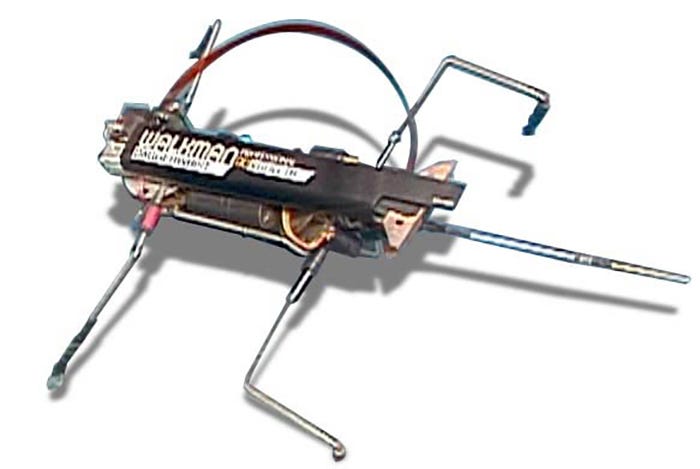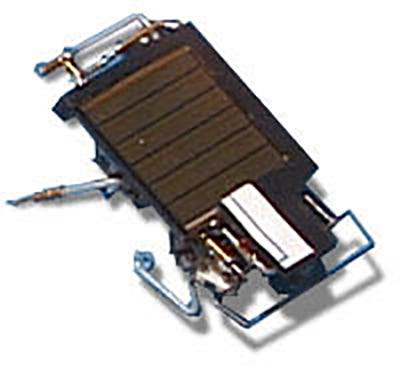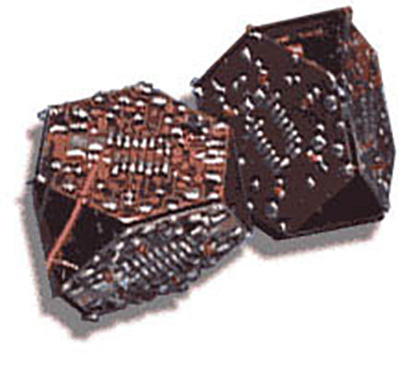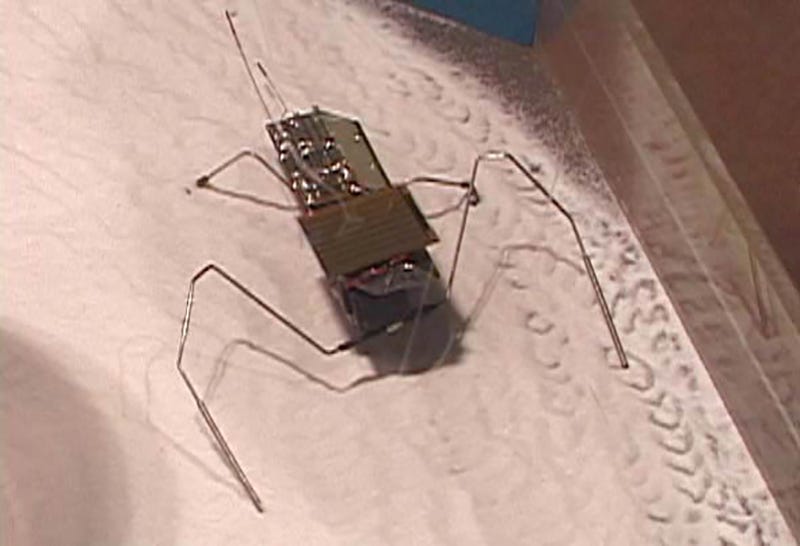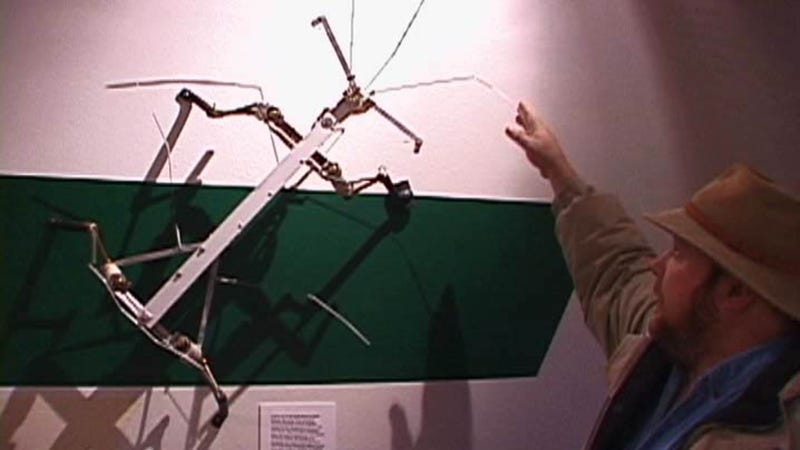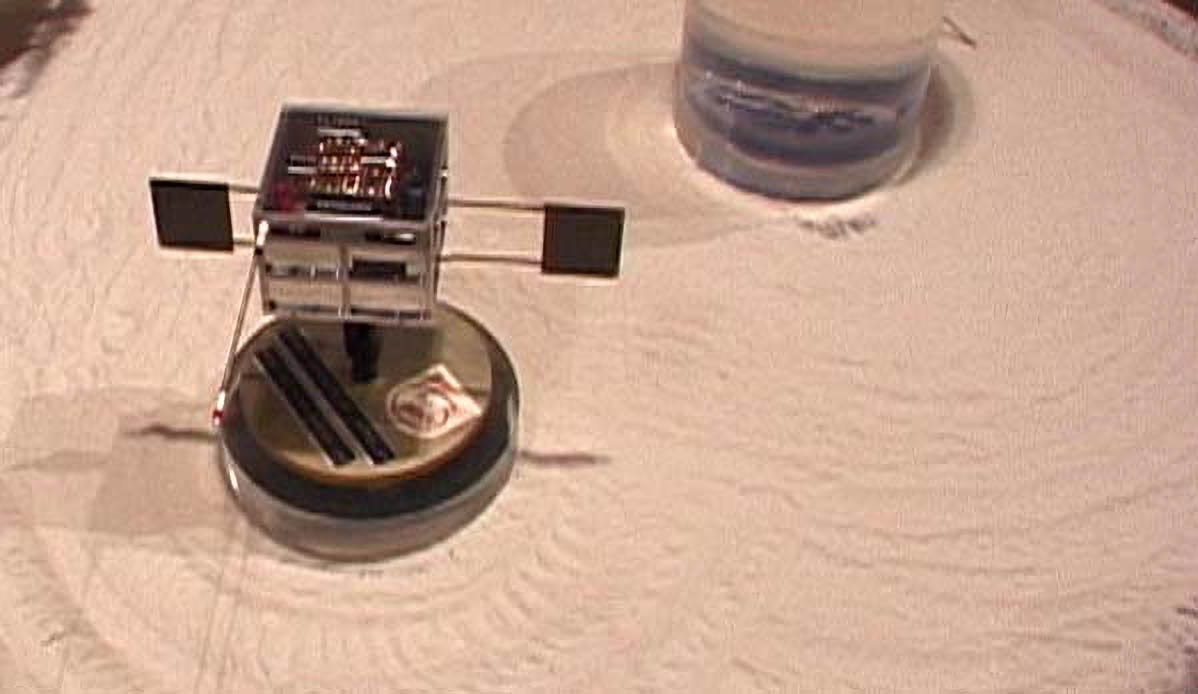Robots without brains
They will change how you think about AI.
Here, published for the first time, is an interview with roboticist Mark Tilden that I conducted way back in 2000. It’s even more relevant today, I think – so-called artificial intelligence has been accelerating rapidly, but his work shows why AI’s physical form has so far been limited to specialized tasks. The reason is counterintuitive: in order for robots to survive in the world outside the computer, we should lose the computer altogether.
“The robots that are going to live in our real world are going to be different from what you normally expect,” Tilden told me. “And it all starts with a paradigm shift in the way that we think about thinking. And that is: We are not rational creatures.”
Learning from living things
We’re surrounded by robots, Mark Tilden tells me. We’re standing in the museum connected to Los Alamos National Lab, the U.S. defence facility where the first atom bomb was developed. The robots are ones that he developed, and they’re far from the androids you see in the movies – these look more like stick insects and satellites.
Most people who make robots encounter what Tilden calls the complexity barrier. They put a lot of time and resources into building a machine that ends up doing very little.
I know this from experience: when I built a robotic cat that recited Shakespeare sonnets (don’t ask), I struggled at first to make its limbs move in a natural-looking way. In the end, I stripped down all the code and simply made them move with some randomness. And guess what – it looked natural.
“The trick is,” Tilden explained, “which is basically nature's trick – is how to get a lot out of very little.”
And so he started with a little, making simple devices out of just a few components – for example, a photocell to collect light, a capacitor to store some energy, and a simple motor. When enough of energy is gathered, it discharges to the motor, making it move just a little at a time. With that, you have something that seeks out the Sun and moves towards it. Useful for exploring Mars, for instance.
From there, the bots basically rediscovered some laws of nature. One example is the Rule of Three, as Tilden explained:
“When you have, say, two digital mechanisms that are sort of talking back and forth to one another, they can either agree or not agree. But if you have three, then two can basically gang up on the other…. By working in groups of three rather than two, you wind up getting a completely different sort of decision variable. That is, something that can make a decision by itself.”
Apply the Rule of Three to hardware and you get hexagonal structures – as found in nature – instead of the rectilinear “Manhattan logic” of binary systems, as Tilden calls it. From simple randomness, like my Catbot, to probabilities. [Note: the Rule of Three also applies to financial markets, another nonlinear system.]
Decisions then lead to interesting behaviors. In hardware, this means a kind of embodied intelligence. And this brings with it a kind of muscle memory without the need for any storage.
If you start simple and work from the ground up, you eventually arrive at legs. Did you ever wonder why there are no wheels in nature?
“What we found,” Tilden said, “was that the signals that are generated by these things wind up being aperiodic. In other words, they move backwards and forwards. Well, if you have these things driving wheels, it creates machines that move backwards, forwards, backwards, forwards. But the problem with wheels is that there's a very limited ability and dimension. That is, they can't travel in all possible directions at the same time.
“Classic example is: You see a friend in a bar. You know where she is, you see her all the time, but you have to negotiate through all the people – a lot of those are moving objects. That's an incredibly sophisticated thing. Why is it that cars on a highway have to stay a car-length away from one another, otherwise you get a crash. But in a mall, people can miss each other by a matter of millimeters, and we don't think anything about it.”
Applied to devices, Tilden said, “You set something to walk, it learns to walk on carpet, then it walks on linoleum, and when it goes back to walking on carpet. It basically ‘remembers’ how to walk on carpet. It doesn't have to learn again. That's just so coincident. I can't help but think that there must be something there.”
This is only one way that natural creatures really explore the world, but intuitively it makes sense, and in fact there is plenty of evidence for this kind distributed intelligence (I discuss cockroaches, for instance, here.)
“And the fact is,” Tilden goes on, “this might be exactly what gives us our ability to create – why human beings can create so easily, whereas machines find it so very hard.”
Such embodied cognition is vital for navigating the real world, and it doesn’t exist in the computer. “Reality works on very different rules, Tilden says. “The problem is, you can't get Reality for Windows. Even if you could, you wouldn't want to. And even if you did, the computer would be so large that you'd have to terraform the moon just to be able to handle the OS.”
Survival of the simplest
Decision-making implies some sort of agency, motives, drive. Even for robots with complex digital brains, we might wonder (or worry) about such a thing.
And indeed, Tilden also worried about this. “We found that our biggest problem was motivating devices to move, to give them an appropriate survival gradient so they would.”
Survival is the key word there – the first instinct for any living creature. It led to Tilden’s three robotic rules, as he recited: “Feed thy ass, move thy ass, and look for better real estate.” If you know your sci fi, you’ll notice immediately that these differ from author Isaac Asimov’s rules, laid out in his book I, Robot.
“Asmimov's rules were essentially, protect humans, obey humans, then look after yourself,” Tilden said. “During the 1980s I built a variety of robots like that, and I wound up with robots that were so scared about doing anything that could possibly displease human beings, that they just sat in the middle of the floor and vibrated. My cat had a field day with that.”
With survival as a primary motivation, that light-seeking robot I described earlier will move on its own to find better real estate (as it defines it). This means actively exploring its environment, in ways that suggest something living. And like a living thing, it’s self-sustaining – no batteries to change, no training or reprogramming.
“It freaks out a lot of people when I deploy my devices,” Tilden laughs, “and I just sit there with my arms crossed while we watch the robot do its thing, without any form of radio control.”
This survival mechanism also means that the robot will just keep going forever – or until it can’t anymore. “We build a variety of devices,” he continued, “and then we leave them powered on for periods of – not days, until the batteries die – but for years. Or until they undergo catastrophic damage.”
Indeed, this caused problems in the exhibition we were standing in. “We've had to glue some of them down,” Tilden told me, looking around, “because even though they're broken and dead, they might still twitch themselves off into the sand.”
Having such stamina, the robots can then be tricked into working for humans, with a little bit of manipulation.
“The whole point,” explains Tilden, “is that you give a device the essential necessities to survive under duress, and then you domesticate it into actually doing a task for you. The same way that you stick a carrot in front of an ox to get it to pull a plow, you can stick light in front of a solar-powered robot to get it to clean your floors.”
Or, clean a minefield. It’s no coincidence that a big US defense lab snapped Tilden up. The addition of a metal detector or magnetic sensor provides an additional motivation for such a working robot.
“The point was for it to actually step on a mine, get a leg blown off, and then pull itself around like robot roadkill as it moved around,” he said. “We did some tests, and it worked very well. But unfortunately, the soldiers didn't like it, because nobody likes to think that a machine could possibly take their job.”
Sound familiar? Debates over automation date back at least to the 19th century Luddites, and have been revived with the rapid rise of AI.
“We hope to be able to restore this idea sometime in the future,” Tilden lamented, “when we can actually get machines out there saving lives, rather than trying to pretend that they're trying to take one.” He compared such robots designed to save lives with that other technology developed by the lab, which is designed to destroy entire cities.
Learning to love the bot
But if survival is a robot’s primary directive, might humans be seen as obstacles? It depends on how we treat it in turn.
“It's really quite fascinating. You have a device that, when you power it on, and you treat it carefully, it will actually realize, ‘Oh, human equals good.’ And it'll follow you around. Power it off, power it on, beat it around, push it away, and it will quickly learn, ‘human equals bad.’ And it will run away into the dark. And as you chase it, it will run away. It's actually learned from its own experience.”
No danger they could turn on us?
“Believe me,” Tilden explains patiently, “no matter how smart we make our devices, we will never have to worry that our toaster is making plots against us. Unless, of course, it's being run by Microsoft.”
So, if robots without brains display some sort of knowledge, memory, and learning, what does this mean exactly, and what might be the implications?
“Remember when I was talking about motivation?” Tilden asks. “What does it take to motivate a complex, distributed controller? It's when things work together smoothly, when there are no conflicts between systems.
“This is why learning something is such a bother for us. If I had to go out there and try and learn tennis, an instructor would be saying, ‘Oh, don't hit it so hard, step back.’ You know, ‘Relax!’”
I had never associated relaxation with learning.
“Your goal,” Tilden goes on, “is to be so smooth with a particular attribute of playing a game, that the barriers between the individual systems that allow you to play that game – that is, between your hands, your arms, your body, your legs, your spine, even the balance mechanism in your head – wind up being so beautifully synchronous with one another that all of a sudden you wind up getting an amazing high-efficiency device.”
A state of flow, as the psychologist Mihaly Csikszentmihalyi calls it.
I said at the start that robots have so far been limited to specialized tasks, as in factory work. But in the past 20 years, we have started to see agile bots able to negotiate complex terrain, pick themselves up after a fall, even play sports. These have no doubt been influenced by Tilden’s work. Back then, he was already starting to integrate more complex controllers.
“We would like to build devices that do show a degree of creativity,” he told me. “But the one thing that we're pleased with right now is that you can build a device that negotiates a complex world, and has only 12 transistors – that's not even enough to build a good radio.
“We have devices we call the queens, which are our nervous net controllers, embedded into another form of nervous net controller. And that allows us to make devices that are, in fact, capable of learning, that are subject to moods.
“Then, on top of that, we might put in a computer that says, ‘What's going on here?’ Whether or not they'll be creative, we're not quite sure. I never make any claims unless I have a robot that proves my point. I’m not a philosopher, I'm an experimentalist. I build. if it works, then I'll show you.”
“So, are these things expanding our definition of intellegence?” I asked.
“They're not expanding our definition of intelligence. It's actually a major controversy in the fields of artificial intelligence and general cognitive studies. Artificial intelligence is based upon the concept that thought is rational – that human beings are innately rational. Well, if you've ever dated some of the people I've dated, you'll suddenly realize what a fallacy that is!
“The thing is,” he continued, “there are so many different variations on the theme. We are under the assumption – and this is backed up by some empirical evidence – that we are irrational creatures. And that is what allows us our degree of creativity, and also allows us one of our fundamental definitions of consciousness.
“What is one of the fundamental definitions of the rights of a conscious creature? That is the ability to be able to do what it needs to do or what it wants to do. That's essentially what satisfies the basic tenet of life. It’s not enough to just be alive, it’s only enough to be alive the way that you want to be alive. Jean-Paul Sartre, 1911.”
Ah, there’s the philosophy. But backed up with experimental evidence.
Cats and components
These bots indeed do a lot with a little, following nature’s example. But the other fascinating thing about them is that they’re also cheap and easy to build, from cast-off electronic components.
“What we found,” Tilden explained, “is that the flotsam and jetsam of modern technology give you a lot of the technology you need to get started building these things.
“In fact, many people would actually pay me to take the junk off their hands. Dead Walkmans and CD players turn out to be the best possible source of appropriate parts for these things…. The contradiction is, it's easier and cheaper to buy a $100 Walkman and tear the motor out, than to buy the motor itself, which is close to $150 and six weeks wait from Japan.”
This is how he started out, and – especially given the growing mountains of electronic waste the world generates – is still a good strategy.
“The original idea,” Tilden recalled, “was to build robots that would, essentially, keep my bachelor pad clean. My original robots wound up eating toilet paper, which got pretty annoying. No matter what sort of program you gave it, you couldn't convince a machine that the cat food was not just something left on the floor, but was meant for the cat.
“So in 1989, I built my very first home-cleaning robot, which was about the size of a pack of cigarettes. My cat immediately destroyed it.”
Tilden’s cat came up again and again in our conversation. That’s actually significant – a cat is not only a good model for movement (as in my Catbot) but a perfect judge of whether a bot resembles a living thing.
“The Turing Test is a test done by Alan Turing,” said Tilden, “which says that if a computer can convince you that it is alive through questions and answers, than it has satisfied the test. We came up with something called the "Purring Test," which is that, if a robot is capable of delivering enough real-world competence to fake out a cat, then you know that you're on your way to building a truly autonomous life form.”
Thus with help and inspiration from his cat, Tilden eventually built some 50 different types of bots, “everything from wall cleaners, electric wallpaper, just things that I can live with.
“I've been living with devices for ten years,” Tilden continued, “and I don't even pay any attention to my machines unless they're not working. I just pick them up, put them in the dishwasher once a year, and then I take them out, and I just throw them around.
“The only thing I have to worry about is when my mother visits. Because then I have to pick up all of my robots and put them carefully away. Because she's seen that episode of Doctor Who, and she knows that the robots will rise up against her in the middle of the night. No. And no matter how much I talk to her, I can't convince her otherwise.”
The swarm-intelligent home
Might it be easier to learn to live with robots that are not as human-like as those in the movies?
“I’ll tell you from experience,” Tilden reflected, “R2D2 – cute little trash can in the movie for two hours. But living with a little, bleeping box for several weeks? Man, you'd claw out the speaker with your fingernails – it's so annoying!
“My vision of the future of robotics is not some sort of R2D2s or Commander Datas walking around, basically fetching you a beer. But something where, when you move into a new house, people have left behind the robots in the same way that they've left behind the lightbulbs. Not because they didn't notice them, but because they were such an implicit part of the house – you wouldn't want to take them away.”
To see a similar vision of the future in action, I recommend a short story by J.G. Ballard, “The Thousand Dreams of Stellavista”.
“And so the house of the future,” Tilden concluded, “will be a place where your windows are clean, your floors are clean, your cockroaches are nervous. Your house just basicallly cleans itself. And the longer you're away, the cleaner it gets. That's a feature, not a bug.”
Want more? Read a full transcript of our interview here for free.
Where is Mark Tilden now? A few years after our interview, he left the lab, moved to Hong Kong to work for Wowwee Toys and produced a series of commercial toy robots, including Robosapiens. But he seems to have disappeared from the internet for the past decade, and Google is no help. If you can help reconnect me with him, I’d be grateful.
Thanks to AI! The images in this article were pulled off of a DV video cassette and were extremely low resolution. Generative AI helped to enlarge and enhance them.

